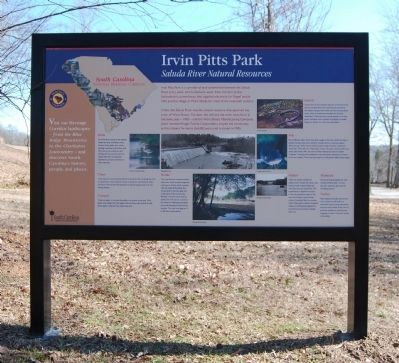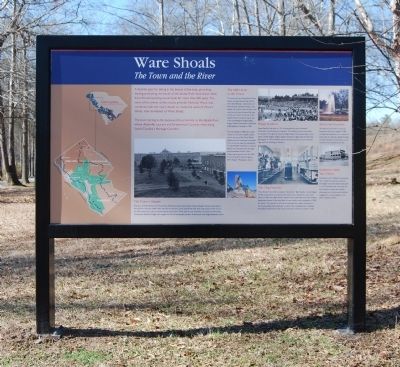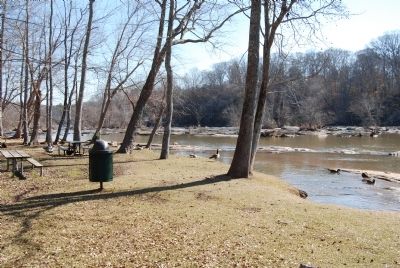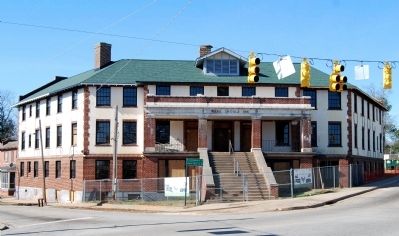Ware Shoals in Laurens County, South Carolina — The American South (South Atlantic)
Irvin Pitts Park / Ware Shoals
Irvin Pitts Park
Saluda River Natural Resources
Irvin Pitts Park is a corridor of land sandwiched between the Saluda River and a canal, which conducts water from the dam to the hydroelectric powerhouse that supplied electricity for Riegel textile mills and the village of Ware Shoals for most of the twentieth century.
In fact, the Saluda River was the natural resource that spawned the town of Ware Shoals. The dam, the mill and the town were born in the same year - 1902 - and the Ware Shoals Manufacturing Company (later renamed Riegel Textile Corporation) shaped the community and its citizens for more than 80 years until it closed in 1985.
Birds
All of the birds native to the upstate inhabit the area, including cranes, herons, ducks, geese, jays, crows, starlings, sparrows and various owls. Wild ducks are sometimes seen drifting with the current over the rapids; they seem to enjoy the experience as much as humans on inner tubes do.
Trees
Trees that are most commonly found in the park area and along the river are sycamores, several species of oak, sweet gums, persimmons, alders, and many river birches that typically are leaning languorously over the flowing waters.
Creeper
Virginia creeper, a harmless five leaflet vine, grows in the area. Wile grape vines dangle from the upper limbs of some trees. Stands of wild canes appear along the river below the park.
Shoals
The river flows for several hundred yards over water-sculptured granite outcrops or shoals, which, coupled with the name of the family that owned the land in the area, gave rise to the name of the community. Perhaps a hundred yards wide at points, the river can be crossed at low water by walking and jumping from one sinuously carved rock to another. The river is a deep as 15 to 30 feet at some points.
Lizards
Lizards seen by the watchful observer are the five-lined skink or bluetail (from the royal blue tail sported by the males), the gray fence swift, and the Carolina green anole, which is sometimes miscalled the Carolina chameleon. While the anole usually appears in its lime green coloration and is capable of changing to shades of gray or brown, it is not a true chameleon.
Fish
Many different types of fish have been caught in the river, which has been a popular fishing locale since residents traveled there in covered wagons 200 years ago. These include small-mouthed, large-mouthed, striped and white bass. There also are white perch, bream, blue gills, channel catfish and, rarely, pike. Since 1981, the town of Ware Shoals has held the Catfish Festival during the last weekend of May that draws thousands of visitors to its town square. There was one report of a 60-pound catfish being caught.
Snakes
There are several varieties of snakes, which inhabit the shoals' area/ Various water snakes inhabit the river, but none are venomous. The copperhead and highland moccasin is the only poisonous snake in the area, but it tries to avoid human contact if possible. Black rat snakes, coach whips, green snakes, and garter snakes are infrequently sighted but can be found by someone seeking them out.
Mammals
Mammals living alongside the river include whitetail deer, raccoon, gray fox, opossum, gray squirrel and flying squirrel.
Turtles
Many species of turtles such as the river cooters or soft shell are commonly seen sunning themselves stop the rocky shoals of the river. If you look closely you may also see snapping or monk "Stink pot" turtles in the water.
Ware Shoals
The Town and the River
A favorite spot for taking in the beauty of the area picnicking, wading and fishing, the banks of the Saluda River have drawn folks from the surrounding countryside for more than 200 years. The name of the owner of the nearby gristmill, Nicholas Ware, was combined with the river's shoals to create the name of Ware's Shoals, later shortened to Ware Shoals.
The town sprang to life because of its proximity to the Saluda River where Abbeville, Laurens and Greenwood Counties meet along South Carolina's Heritage Corridor.
The Town's Origins
The town of Ware Shoals and Ware Shoals Manufacturing Company (later renamed Riegel Textile Corporation) were born in the same year - 1902. Nat Dial of Laurens county started the river dam construction at the turn of the 20th Century as a means of powering his cotton plant. When Dial ran out of money, he turned to New Jersey businessman, Benjamin Riegel who bought the mill and completed the dam. At the same time, Riegel fathered a town.
The Mill's Role in the Town
The economic and social life of ware Shoals revolved around the mill for more than 80 years. Generations of Ware Shoals' families worked in the textile mill, and for many of them, this was the only job and way of life they would ever know. Once one of the largest textile manufacturing centers of the southeastern United States, Riegel Textile Corporation employed 5,000 people at its peak in 1960.
The mill closing in 1985 had a major impact on the town's 2,000 citizens and its economy. But Ware Shoals fought back and continued to prosper. The mill site has been the beneficiary of a $2,700,000 investment in cleanup efforts and redevelopment through the Brownfields Project. Ware Shoals was presented with the 2001 Environmental Protection Agency (EPA) Region 4 Rising Star Award.
Riegel Stadium
Riegel Stadium was built in 1931 utilizing laborers from President Roosevelt's nation-wide job program. The stadium is most renowned for baseball. Through the decades, Riegel Stadium has hosted high school teams, textile leagues, Negro leagues, American Legion ball and even the big leagues. A 1954 exhibition game here showcased the Cincinnati Red Legs and the Washington Senators.
Memorial Fountain
The Memorial Fountain in front of Katherine Hall was created in 1968 through the dedication of a number of local clubs to raise the needed funding and gifts donated as memorials to war veterans who worked at the mill.
The "Big Friendly"
Ware Shoals Town Hall is located in the former "Big Friendly," as the Riegel Textile Corporation's company store was known. Started as a one-room shanty in 1906, the "Big Friendly" became one of the finest and most modern department stores in the state after its new location was completed in 1920. Its motto, "You can buy in one store anything from a paper and pen to a Ford automobile, from a baby girl's rattle to her wedding dress" reflected the extent of the store's role in the community. The store closed in 1963.
Katherine Hall/The YMCA
Dedicated as the "Peoples' Amusement Hall," Katherine Hall was named for the Riegel's only child when it was built in 1913. Katherine Hall, the center for the mill workers to relax, has housed a wide spectrum of community activities ranging from a movie theater to the Senior Citizens Center.
Erected by South Carolina Heritage Corridor.
Topics and series. This historical marker is listed in these topic lists: Environment • Industry & Commerce • Settlements & Settlers • Waterways & Vessels. In addition, it is included in the South Carolina Heritage Corridor series list. A significant historical year for this entry is 1902.
Location. 34° 24.233′ N, 82° 14.35′ W. Marker is in Ware Shoals, South Carolina, in Laurens County. Marker is on Power House Road, on the right when traveling east. While most of Ware Shoals is in Greenwood County, a portion, largely on the east side of the Saluda River, lie within Laurens County. Touch for map. Marker is in this post office area: Ware Shoals SC 29692, United States of America. Touch for directions.
Other nearby markers. At least 10 other markers are within 5 miles of this marker, measured as the crow flies. Marion P. Carnell Bridge (about 700 feet away, measured in a direct line); Benjamin DeWitt Riegel (approx. half a mile away); Ware Shoals Veterans Memorial (approx. 0.6 miles away); Ware Shoals School / Ware Shoals High School (approx. ¾ mile away); Ware Shoals High School Veterans Memorial (approx. ¾ mile away); The William T. Jones, III Bridge (approx. 1.2 miles away); Martin's Store (approx. 2.4 miles away); Western Laurens Volunteer Fire Department (approx. 3.4 miles away); Good Hope Baptist Church (approx. 4.2 miles away); Mt. Bethel United Methodist Church (approx. 4.6 miles away). Touch for a list and map of all markers in Ware Shoals.
Also see . . .
1. Ware Shoals, South Carolina. Ware Shoals is a town in Abbeville, Greenwood, and Laurens counties in the U.S. state of South Carolina, along the Saluda River. (Submitted on January 25, 2009, by Brian Scott of Anderson, South Carolina.)
2. 28th Annual Ware Shoals Catfish Festival. The 2009 Ware Shoals Catfish Festival will be held on the Friday and Saturday of Memorial Day Weekend. (Submitted on January 25, 2009, by Brian Scott of Anderson, South Carolina.)
3. Ware Shoals Inn. The Ware Shoals Inn is significant for its association with the textile industry in South Carolina and for its prominent role in the life of the Ware Shoals community. (Submitted on December 25, 2010, by Brian Scott of Anderson, South Carolina.)
4. Saluda River. The Saluda River is a principal tributary of the Congaree River, about 200 mi (320 km) long, in northern and western South Carolina in the United States. (Submitted on December 25, 2010, by Brian Scott of Anderson, South Carolina.)
5. Riegel Linen. Riegel Textile Corporation was sold to Mount Vernon Mills and renamed Riegel Linen, now headquarted in Johnston, South Carolina. (Submitted on December 25, 2010, by Brian Scott of Anderson, South Carolina.)
6. iNaturalist entry for Irvin Pitts Memorial Park. (Submitted on April 19, 2024, by Phillip Harpootlian of Simpsonville, South Carolina.)
Additional commentary.
1. Ware Shoals Inn
The Ware Shoals Inn is a three-story brick building with a partial basement. The modified V-shaped building faces east, with a massive raised porch at its truncated vertex. Exterior walls of the lower level are finished in dark brick, while the upper two floors feature light-colored stucco. This design and the site’s sloping topography enhance the building’s dominance at one of the town’s most prominent intersections. Although the Inn has undergone several renovations and suffered a fire since its construction in 1923, the interior retains a high level of integrity, and the original exterior appearance is virtually intact.
Located at the point where three major streets intersect, the Ware Shoals Inn was built on a wedge-shaped lot bounded by West Main Street on the southeast and North Greenwood Avenue on the northeast. Saluda Avenue also extends north from this intersection. The hotel takes full advantage of this situation, with wings extending along both Main and Greenwood. Instead of designing a true V-shaped building to fit the space, the architect truncated the point and in its place added a monumental portico that forms a critical focal point for the town. This effect is further enhanced by placing the main entrance on the second level and by adding a prominent flight of steps that lead from the sidewalk to the porch.
The Ware Shoals Inn is constructed of brick, with exterior walls of the upper two levels finished in light-colored stucco. The lower level features dark, textured brick to create the effect of a two-story building on a raised foundation. Brick is also used on the upper two levels for ornamental purposes, as surrounds for windows and doors, and as quoins at the corners.
The main entrance, originally composed of three sets of double doors with transoms, is centrally located on the middle level. A secondary entrance at ground level is located beneath the porch at the Greenwood Avenue elevation. Single, double-hung windows are evenly spaced throughout the building. Most of
the middle- and upper-level windows have eight-over-eight lights. The building has a hipped roof that terminates in gabled parapets at the end of each wing. There is a deep overhang with exposed rafter ends. A gabled dormer with four rectangular louvered vents pierces the front roof slope, adding further emphasis to the main entrance. There are two interior brick chimneys.
The building’s façade is nine bays wide, the central five-bay section of which projects slightly to intersect with the porch. The porch itself is supported by massive brick piers, enclosed at ground level with fixed-glass and double-hung windows. The wide flight of steps leading to the porch is constructed of concrete and brick, surmounted by concrete coping along the sides, and with triangular windows beneath to admit light. The porch has four brick pillars and two corresponding pilasters with concrete bases and caps. There is an ornamental wrought-iron rail, tile floor, and plaster ceiling. The flat porch roof features a terra cotta cornice with dentil molding and a brick parapet. Applied to the fascia above the steps is the name “Ware Shoals Inn” and date “1923.”
The gable end of each wing has a single window on each level, providing access to a metal fire escape. There is a single rectangular louvered vent in each gable. A two-story gabled addition projects from the center of the rear elevation, incorporating design elements of the main section (such as brick exterior on the ground level and stucco above).
The interior layout is typical of a small hotel of that era, with a centrally located lobby and reception area, and corridors providing access to rooms on each side.
The main lobby is dominated by a large inglenook directly opposite the front doors. The original exposed brick, segmental arch, high wainscoting, plaster walls, and built-in benches remain largely intact. Other public areas, such as hallways and stairwells, feature plaster ceilings and walls with beaded wainscoting and a chair rail. Single doors with transoms provided access to guest rooms. Many of the doors have been replaced or are missing, and most transoms have been closed. The simple surrounds typically are original and intact. Stairs feature wood steps and plain wood railings. Floors throughout the building are wood, with tile in the lobby area.
In addition to the main level lobby, the Inn had public meeting rooms on each level. On the upper level, directly above the lobby, and overlooking the roof of the porch, was the Bamboo Room, so named for the furniture that once was located there. On the ground level, in the Greenwood Avenue wing, was the Radio Room, similarly named for its most noteworthy feature. Also on the ground level, directly beneath the lobby, is the dining room, with kitchen to the rear.
Sections of the interior have been altered due to deterioration, fire, and renovation projects. Neglect and vandalism in recent years also have compromised original material. Typical changes include damaged plaster, missing doors, dropped ceilings, and rotted floors. In each case, sufficient material remains in other areas of the building to convey the original design. None of the alterations is substantial enough to compromise the overall integrity of the Inn.
The building itself occupies the majority of the nominated property. A paved parking area is located to the rear. There are no outbuildings or landscaped areas associated with the Inn. Neighboring properties include a row of townhouse apartments (approximately the same age as the Inn), commercial buildings, a church, the community building (Katherine Hall), and town park.
Significance
The Ware Shoals Inn is significant for its association with the textile industry in South Carolina and for its prominent role in the life of the Ware Shoals community. Built by the Ware Shoals Manufacturing Company in 1923, the Inn served for decades as a center of activity in the village. The building incorporates elements of popular architectural styles of the period and is situated at one of the more visible locations in town. Possessing a high degree of architectural integrity, the Inn has become even more prominent as a symbol of the town’s past since the destruction of the Ware Shoals Mill buildings.
Historical Background and Significance:
The Ware Shoals Manufacturing Company was chartered in 1902 and soon began construction of a textile mill and village along the Saluda River at the northern tip of Greenwood County. In 1905, Benjamin D. Riegel of New York obtained a substantial interest in the company, and under his direction the business and community experienced great growth.
As its textile operations and manufacturing plants expanded, the company also oversaw the addition of religious, recreational, and other facilities to serve the community, its citizens, and visitors. One such building was the Ware Shoals Inn.
The current building replaced an earlier inn of frame construction, which was located nearby. After the new brick inn was completed, the old building was converted to apartments. It is no longer standing.
The Inn was built by and for the Ware Shoals Manufacturing Company as an integral part of its development of the community. Even though it was a public establishment, one of the hotel’s principal uses from the beginning was to provide lodging for persons having business with the mill and its employees. The Inn, along with the Riegel House (no longer extant), served as home away from home for company executives visiting from the headquarters in the northeast.
Construction appears to have begun in late 1922. The Index-Journal, a newspaper published in the county seat of Greenwood, printed a story entitled “Ware Shoals Is On A Boom” in its issue of 11 March 1923. It stated in part, “The hotel, begun here several months ago is beginning to look like a hotel should and when completed it will be one of the best equipped and modern hotels to be found even in the larger cities. It will have around fifty rooms with hot and cold water and baths and steam heat. It is hoped that the building will be completed by May.”
That prediction was accurate, as the 29 April 1923 edition featured a lengthy article entitled “Ware Shoals Handsome New Hotel Reflects Rapid Growth of Mill Community the Past Few Years.” After giving a summary of the first two decades of the Ware Shoals Mill community, it reported, “Another recent building that has been added to Ware Shoals is a large fifty room hotel, completed and opened up this week. The hotel is furnished lavishly throughout and is uniform and offers the best hotel accommodations to be found anywhere, even in the large cities. Fifty bed rooms [sic] with baths, hardwood floors, dining room and electric kitchen is its capacity. The hotel is a beautiful structure, in a central part of the village and an ideal location. …” The formal opening of the Inn took place on May 3, with Mr. Riegel and other officials from New York in attendance.
Once opened, the hotel offered lodging not only to travelers. New employees of the mill, including married couples and their children, also found a temporary home at the Inn while waiting for a permanent house or apartment to become available in the village. Schoolteachers rented rooms by the month during the academic term, many maintaining their residence there for years.
In addition to lodging, the Ware Shoals Inn provided other amenities to guests and local citizens. It had a public dining room and smaller meeting rooms. Two popular spots were the Bamboo Room on the upper floor above the lobby and the Radio Room down the hall from the dining room on the ground level. The former took its name from the type of furniture it contained and was a much-desired venue for receptions and other small gatherings. The latter was a popular site for those interested in hearing news and entertainment from abroad.
In 1929, Dr. B.R. Johnson was advertising his services as a dentist with an office in the Ware Shoals Inn. That same year, Dr. D.W. Daniel of Clemson College spoke to the organizational meeting of a group of “about sixty overseers, superintendents, second hands and bosses” in the Radio Room, followed by a dinner in the dining room. In 1930, the Inn was invited to join the Southern Association of Hotels. Newspapers of that period report that the hotel hosted meetings of the Goodfellows Club, American Legion, and other groups. It also was a popular site for weddings and receptions.
Even though the Inn always had a steady stream of regular visitors and part-time residents, it remained a public hotel and advertised as such. A postcard, presumed to date from the 1930s, touted its appeal:
52 Rooms: Fire-proof and Steam Heat
WARE SHOALS INN
WARE SHOALS, S.C.
Located on Greenville-Augusta Highway
The Ware Shoals Inn is one of the newest and most modern hotels in the Northwestern part of South Carolina. In addition to 52 modern rooms, most of them with private bath, every room is an outside room well ventilated. Free Garage service for hotel guests.
The Ware Shoals Inn maintains an excellent dining room where the civic clubs meet regularly. It is a member of the Southern Hotel Association. It is operated on American and European plan. Special rates quoted by week or month. Rates from $1.50 up.
Owned and operated by Ware Shoals Mfg. Co.
The Inn continued to operate for decades, even as the textile industry was undergoing changes. Its value to the company was underscored in 1946, when the assets of Ware Shoals Manufacturing Company were transferred officially to the Riegel Textile Corporation. In doing so, a decision was made to divest the company of certain properties, including churches, manses, schools, the community building (Katherine Hall) and pool, and the post office. The Inn was retained, along with the mill buildings, houses, and other improvements. By implication, it appears that the directors of the company had decided that the Inn still played an integral role in mill operations.
Newspapers from the late 1940s indicate that the Ware Shoals Inn continued to enjoy a prominent place in the life of the community. It was the site of regular dinner meetings of the Lions Club, and was often the chosen place for wedding receptions and rehearsal dinners. In 1947, a flower contest held at the Ware Shoals Inn led to the creation of the Friendly Garden Club, which continued to hold its regular meetings there.
Four decades after its opening, the Inn retained its reputation as a popular place for community activities. In February of 1964, the town newspaper reported that a well-attended Father-Son banquet of the local Boy Scout troop was held at the Ware Shoals Inn.
By 1971, however, times had changed, and Riegel decided to sell the Inn. In announcing the June 12 closing, a company official stated, “Although the Inn has served the community well over the years, it can no longer be operated efficiently. Therefore rather than investing further in a building that needs so much improvement to be modern, we believe it is better to step aside and allow modern hotel facilities to meet those needs.”
The Inn gained a reprieve when Riegel Textile Corporation sold the property that year to Tom and Mildred Clamp, who continued to operate it as the Ware Shoals Inn. The Clamps immediately began a renovation that included exterior painting, new boiler system, remodeled dining room, and new glass doors and windows for the lobby.
Eventually, the Inn closed for good. Ownership passed through several hands until April 2006, when Vision Ware Shoals, LLC, purchased the Inn, with plans to convert it to apartments.
The Ware Shoals Inn is significant architecturally as an expression of the textile company’s influence on the design of a building that is not traditionally associated with mill villages. The massing and form are straightforward and efficient, with few features that are solely decorative in nature. Even so, the Inn’s design incorporates elements of the Arts and Crafts movement and Colonial Revival style to set it apart from the manufacturing facilities nearby. The end result is a building that is distinctive from, yet blends well with, its surroundings.
The placement of the building at a prominent intersection, with an elevated entrance facing the corner, also commands attention. The building not only is aesthetically pleasing individually; it also fits well into the village, complementing the industrial buildings on one side and the residential sections of town on another. (Source: National Register nomination form.)
— Submitted December 25, 2010, by Brian Scott of Anderson, South Carolina.
Credits. This page was last revised on April 19, 2024. It was originally submitted on January 25, 2009, by Brian Scott of Anderson, South Carolina. This page has been viewed 8,248 times since then and 235 times this year. Last updated on May 29, 2010, by Deb Henderson of Greenville, South Carolina. Photos: 1, 2, 3, 4, 5, 6, 7, 8, 9. submitted on January 25, 2009, by Brian Scott of Anderson, South Carolina. • Kevin W. was the editor who published this page.








